The main purpose of carburizing the drill rod of a rock drill during the production process is to optimize the balance between the surface and core properties of the material, and improve its durability and reliability under harsh working conditions. The following is the specific purpose and technical analysis of carburizing treatment:
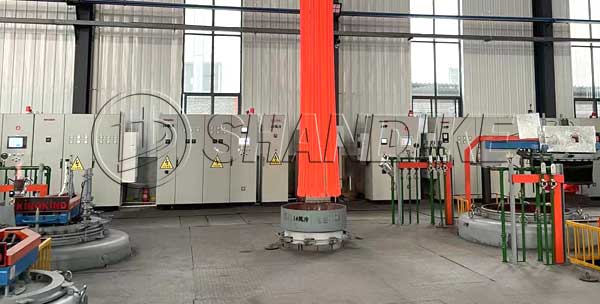
-Mechanism: Carbonization is achieved by infiltrating carbon elements into the surface of the drill rod, forming a high carbon layer (usually with a carbon content of 0.8% -1.2%), followed by quenching and low-temperature tempering, resulting in the formation of a high hardness martensitic structure on the surface.
– Effect : The surface hardness can reach HRC 58-64, significantly improving the wear resistance, addressing wear problems caused by friction with rocks, and extending the life of drill pipes.
-Material selection: The drilling rod matrix is usually made of low carbon steel (such as 20CrMnTi), which has a low carbon content in the core after carburizing (about 0.1% -0.3%), low hardenability, and retains a tough structure (such as ferrite+pearlite).
-Performance Balance : The high toughness core can absorb impact energy, prevent brittle fracture of drill rods during high-frequency impact operations, and adapt to the high dynamic load conditions of rock drills.
-Process influence : The volume of the carburized layer expands during quenching, forming compressive stress on the surface, offsetting the tensile stress during operation, and delaying crack initiation. – Fatigue resistance improvement : Surface compressive stress state can increase the bending fatigue strength of drill pipes (by about 30% -50%), reducing fatigue failure caused by cyclic stress.
-Cost effectiveness: Compared to overall high alloy steel, carburizing treatment reduces material costs while ensuring performance, making it suitable for mass production.
-Depth control: The depth of the carburized layer is usually designed to be 0.8-1.5mm (adjusted according to the diameter of the drill pipe), taking into account wear resistance requirements and avoiding excessive thickness of the brittle layer.
-Improved anti bite performance: The high hardness surface reduces adhesive wear when in contact with rocks.
-Dimensional stability: Low temperature tempering (180-220 ℃) reduces deformation while maintaining hardness, ensuring the geometric accuracy of the drill rod.
-Process control: Accurate control of carburizing temperature (900-930 ℃), time, and carbon potential is required to avoid grain coarsening or excessive carburizing leading to brittleness.
-Subsequent processing: Grinding is required after carburizing to eliminate the oxide layer and ensure assembly accuracy.
Through carburizing treatment, the drill rod of the rock drill achieves a gradient performance of “external hardness and internal toughness”, and its comprehensive service life can be increased by 2-3 times compared to untreated drill rods. It is a key process that balances performance and economy.
Dear Customer,
We will participate in bauma CHINA 2024 during November 26-29 at Shanghai New International Expo Centre (SNlEC). We will display our new products and present advanced solutionson the leading trade fair for construction machinery, building material machines, mining machines and construction vehicles. We cordially invite you to attend the grand event and visit our booth.
Welcome to our BOOTH:NO.E5.861

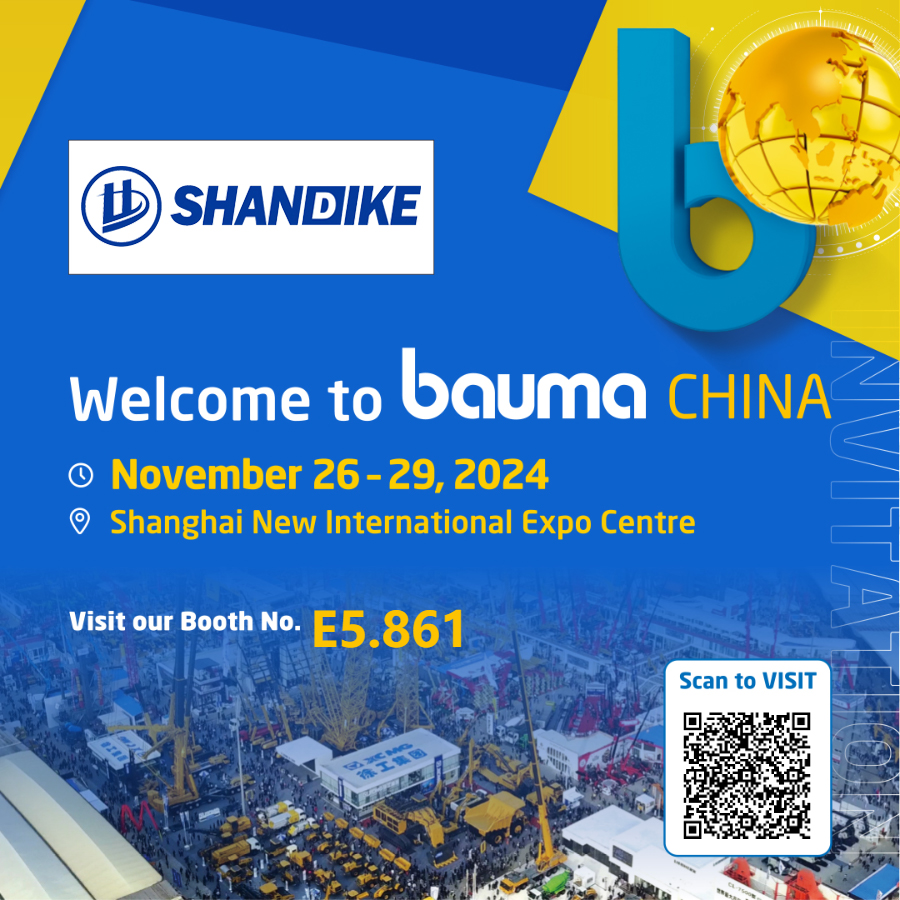
Top hammer thread drilling rod 28mm (diameter 28mm)
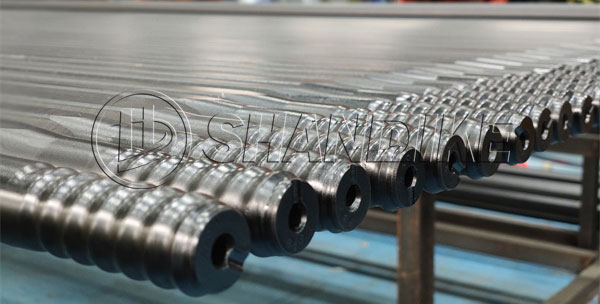
1、 Product Overview
Name: Top Hammer Thread Drilling Rod 28mm
Diameter: 28mm
Type: Top Hammer Threaded Drill Rod
Purpose: Mainly used in engineering fields such as mining, rock drilling, tunnel excavation, etc.
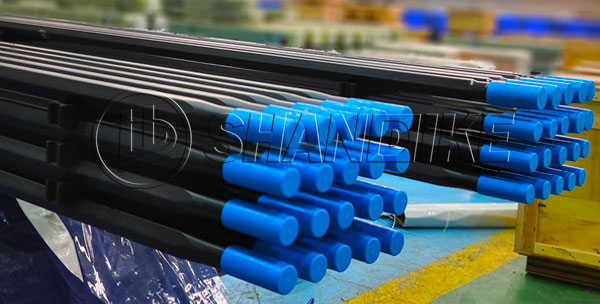
2、 Product Features
High strength: The drill rod is made of high-quality alloy steel, which has high strength and wear resistance, and can withstand large drilling pressure and torque.
High precision: The threaded part adopts precision machining technology to ensure a tight and reliable connection with the drilling rig, reducing shaking and vibration during the drilling process.
Long service life: After special heat treatment process, the service life of the drill rod is significantly improved, reducing the frequency and cost of replacement.
3、 Purchase advice
Choose suppliers with good reputation: When purchasing, priority should be given to suppliers with good reputation and high-quality reputation to ensure product quality and after-sales service.
Understand product details: Before purchasing, it is necessary to thoroughly understand the specifications, materials, performance, and other parameters of the product to ensure that it meets one’s own usage needs.
4、 Application Fields
Comparing prices and services: When purchasing, you can compare prices and services from different suppliers and choose products with high cost-effectiveness.
Pay attention to transportation and installation: After purchasing, pay attention to the transportation and installation process of the product to ensure that it can arrive safely and accurately at the site of use, and be installed and used correctly.
The use of the Top Hammer Thread Drilling rod 28mm (diameter 28mm) is mainly concentrated in mining, rock drilling, tunnel excavation, and other engineering fields that require deep hole drilling. Here are its specific uses:
Mining: In mines, drill rods are used to extract mineral resources such as ores and rocks. Through drilling, the distribution and reserves of ore can be determined, providing data support for subsequent mining.
Rock drilling: In geological exploration, geotechnical engineering and other fields, drill rods are used to drill rocks to obtain geological information underground. This helps to understand underground structures, rock distribution, hydrogeological conditions, etc., providing a basis for engineering design and construction.
Tunnel excavation: In tunnel engineering, drill rods are used for excavation operations. Through drilling, rocks can be broken and tunnels can be excavated, providing a pathway for subsequent construction work.
Other engineering fields: In addition to the above-mentioned fields, drill rods are also widely used in engineering fields that require deep hole drilling, such as water well drilling, geothermal resource development, and anchoring engineering.
When in use, the drill rod is connected to the drilling rig through threads, and is pushed into the ground for drilling by the top hammer of the drilling rig. The diameter, length, and material parameters of the drill rod will be selected based on specific drilling requirements and geological conditions.
5、 Market price
The price of the Top Hammer Thread Drilling rod 28mm (diameter 28mm) may fluctuate due to various factors such as market supply, product quality, production costs, purchase quantity, and regional differences.
1、 Price Range
Generally speaking, the price of the Top Hammer Thread Drilling rod 28mm may vary depending on different suppliers, brands, and quality levels.
In the market, entry-level products with relatively low prices can be found, which may be manufactured using common materials and processes, suitable for some drilling operations that do not require high performance.
At the same time, there are also high-end products with higher prices, which are usually made of high-quality alloy steel, processed with precision machining and special heat treatment processes, and have higher strength, wear resistance, and service life, suitable for drilling operations with high performance requirements.
2、 Price influencing factors
Market supply situation: The supply of drill pipes in the market will directly affect their prices. If there is sufficient supply of drill pipes in the market, the price may be relatively low; If supply is tight, prices may rise.
Product quality: Product quality is an important factor affecting price. High quality products are usually manufactured using better materials and processes, with higher performance and longer service life, so the price will also be relatively high.
Production cost: Production cost includes raw material cost, processing cost, transportation cost, etc. If production costs increase, suppliers may raise product prices to maintain profit levels.
Purchase quantity: The purchase quantity is also a factor that affects the price. Generally speaking, the larger the purchase quantity, the supplier may offer a certain discount or discount.
Regional differences: Market demand, consumption levels, and logistics transportation costs in different regions can also affect the price of drill pipes.
3、 Price advice
Consulting suppliers: directly contact suppliers or manufacturers to obtain the latest product quotations and discount information.
Compare different suppliers: Compare product quotes and quality from different suppliers in the market, and choose products with higher cost-effectiveness.
Follow market trends: Pay attention to industry developments and market price trends in order to make purchases at the appropriate time.
In summary, the price of Top hammer thread Drilling rod 28mm will be influenced by various factors, and the specific price needs to be determined based on market demand, product quality, production costs, and other factors. When making a purchase, it is recommended to consult multiple suppliers and compare the prices and quality of different products to choose the one with higher cost-effectiveness.
Due to the development of China’s mining industry and the increasing scale of transportation infrastructure construction, as well as the government led requirements for mechanization, automation, and intelligent unmanned construction and mining, the drilling tool market has developed rapidly. It is said that there are dozens of manufacturers with a market size of billions of yuan. But there is still a lot of room for improvement in the performance of domestic brand products.
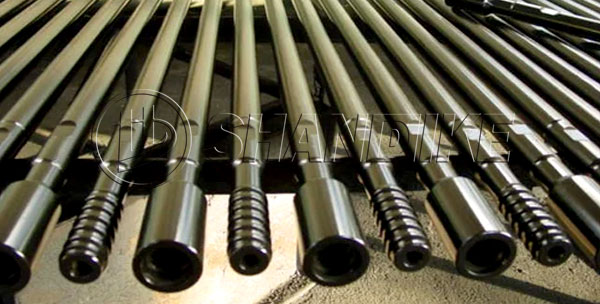
Today, let’s talk about our experience with the failure of drill rods on rock drilling rigs.
As the drill rod of the excavation trolley, it is the conductor that transfers the impact energy of the rock drill to the rock. Its working form is shown in the figure above. Regardless of the specifications, there are mainly several failure modes, namely normal wear. In addition, one is the breakage of the drill rod, and the other is the deformation of the connecting thread wear. Thread wear and deformation are common, while fractures are relatively rare, but the fracture points are almost always located about 50 centimeters away from the thread sleeve.
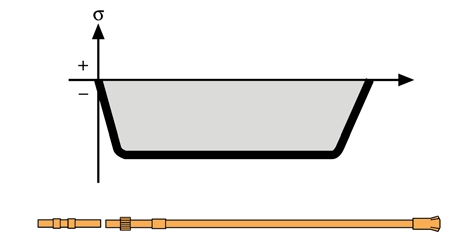
This situation is actually very consistent with the theory of energy transfer fluctuations in rock drills. When the impact piston strikes the drill tail, the kinetic energy of the impact piston is converted into stress waves, which are transmitted to the bottom of the hole through the drill rod and drill bit. In order to achieve optimal drilling economy, the entire system from the rock drill to the drilling tool to the rock must be coordinated with each other. According to the stress wave theory, stress waves are rectangular in shape, with the length of the rectangular wave being twice the length of the piston. The height of the rectangular wave depends on the velocity of the piston at the moment of impact, as well as the relationship between the cross-sectional area of the impact piston and the cross-sectional area of the drill rod, as shown in the figure. The energy generated by the impact of the rock drill piston is transmitted in the form of waves through the drill rod tail, and the drill rod breaks the rock. If you have hit a large hammer, held a drill rod, or chiseled a nail, you can feel the slight expansion of the drill rod with your palm or fingers, and have a sensory experience. According to this theory, at any given impact pressure, the stress wave amplitude in the drill pipe, i.e. the stress value, will become higher due to the reduction in the cross-section of the drill pipe. In order to achieve a longer service life for the drill tail and drill rod, it is important to ensure that the working pressure matches the cross-sectional size of the drilling tool at all times. Atlas Copco’s rock drills all adopt the concept of slender piston, and hope that the diameter of the drill bit tail and the drill rod match with it and are uniform without change, so that the peak value of the energy wave is uniform, which can not only achieve high transmission efficiency, but also improve the life of the drilling tool. This is also why Atlas rock drill is more efficient than other brands.
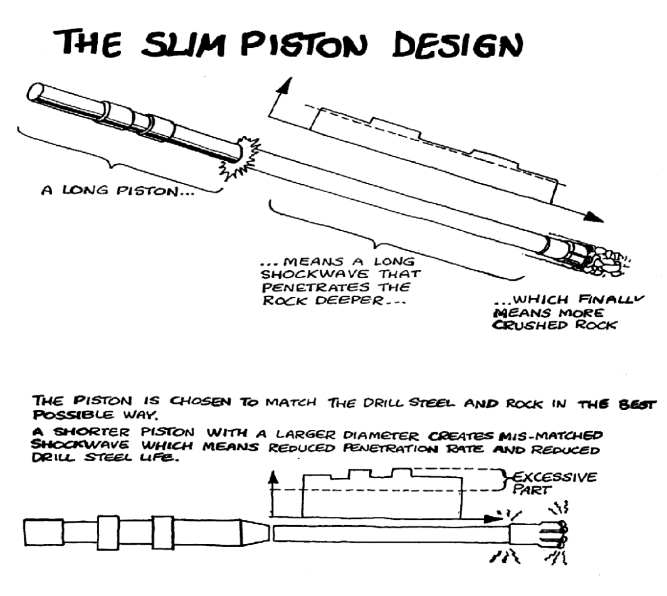
However, in reality, whether it is a drill tail or a drill rod, due to functional and processing requirements, its structural shape is difficult to fully meet the condition of no change in diameter. From the figure, we can see that in excavation and rock drilling, whether using an integrated fast drill rod or a connecting sleeve, the connection thread between the drill rod tail and the drill rod is the place where the amplitude of the shock wave changes the most, that is, where the shock wave peak will be generated; The accuracy of thread machining, the matching degree of mutual cooperation, and even the deflection changes during the working process of the drill pipe have the greatest impact on this part, which is why drill pipe failures occur more often in this area. So, if drilling tool manufacturers can make efforts in this area, there is still a lot of work to be done.
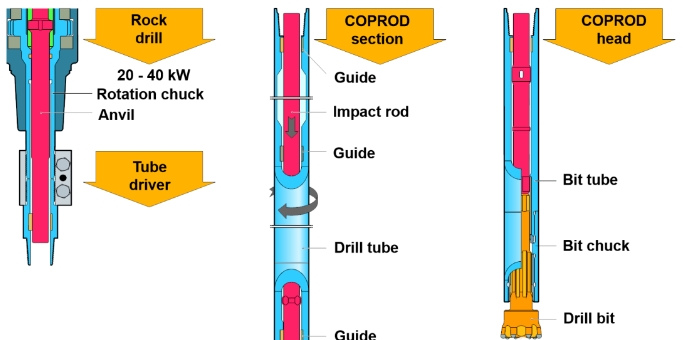
But in reality, I believe that only improvement can be made. In a sense, this problem is unsolvable for horizontal excavation and rock drilling.
In open-pit rock drilling, down the hole hammers are now more commonly used, and since the drill pipe does not withstand impact, there is no such problem. Atlas skillfully used a kind of drill tool called COPROD for top hammer drilling. As shown in the figure, the outer casing does not bear impact, and the internal impact rod does not use threaded connection, but uses lap joint, so the diameter will not change, and the waveform will not have peak changes. The drilling speed and the life of the drilling tool are both very long, but basically it is only suitable for vertical drilling.
Product Introduction: Drifter Rod (Threaded Drill Rod, Hydraulic Drill Rod, Heavy duty Drill Rod)
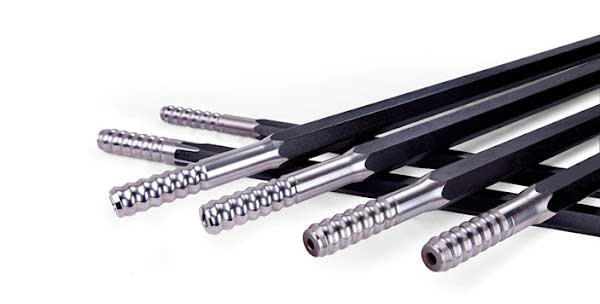
Drifter rod, also known as threaded drill rod, hydraulic drill rod or heavy-duty drill rod, is an efficient tool designed specifically for breaking rocks. This unique hollow hexagonal rod is equipped with precision connecting threads at both ends, allowing it to effectively transmit the impact force and torque of hydraulic rock drills, easily handling various hard rock layers.
1、 Product Definition and Functionality
The core function of the Drifter rod is its ability to efficiently transmit power, converting the powerful energy of hydraulic rock drills into the actual effect of breaking rocks. Its hollow hexagonal design not only reduces weight, but also enhances overall strength and stability, ensuring stable operation in various harsh mining and excavation environments.
2、 Main specifications
In order to meet the needs of different customers, the Drifter rod offers a variety of thread forms to choose from, including R25, R28, R32, T38, T45, T51, ST58, GT60, etc. These different thread forms can be adapted to various models of hydraulic rock drills, ensuring the best matching effect and the highest work efficiency.

3、 Type
Drifter rods are mainly divided into two types: quick drilling rods (MF rods) and extended rods (MM rods). Fast drilling rods are known for their ability to quickly penetrate rocks and are suitable for work scenarios that require efficient excavation; Extending the drill rod expands the operating range by increasing its length, suitable for deep or difficult to access rock layers.
4、 Application Fields
With its strong crushing ability and adaptability, Drifter rods have been widely used in construction projects such as open-pit mining, underground mining, tunnel excavation, and quarrying. It can not only improve work efficiency, but also reduce the labor intensity of workers, making it an indispensable and important tool in these fields.
5、 Selection factors
When choosing a Drifter rod, customers need to consider multiple factors to ensure that they select the product that best suits their needs. These factors include application scenarios, specifications, materials (such as high-strength alloy steel to improve wear resistance and strength), load and torque requirements, manufacturer reputation, and budget.
6、 Recommended brand
Among numerous Drifter rod brands, we strongly recommend the SHANDIKE brand. SHANDIKE always adheres to the principle of quality first and technological leadership, and is committed to providing customers with the highest quality products and services. The Drifter rods produced by it not only have excellent performance, but also reasonable prices, making them an ideal choice for customers. In addition, SHANDIKE also provides global export and professional after-sales service to ensure that customers receive comprehensive support during use.
7、 Contact Information
If you are interested in SHANDIKE brand Drifter rods or need more information, please feel free to contact us at any time.

Company Name: Luoyang Shandike Mechanical Equipment Co., Ltd
Email: [email protected]
Phone:+86 19937978951
WhatsApp:+86 19937978951
Office Address: Room 2311, Nanchang Road, Luoyang City, China
Factory Address: No.1 Lihe Avenue, Yiyang County, Luoyang City, China
To maximize the service life of your down-the-hole drill bits, consider implementing these comprehensive strategies:
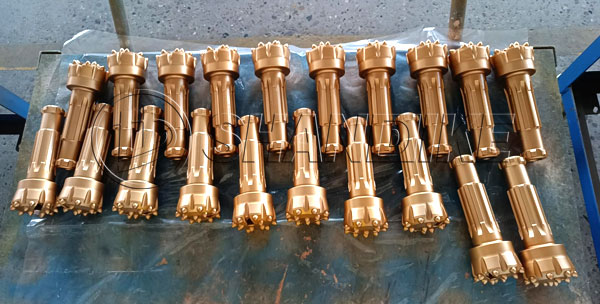
Material Selection and Quality Assurance:
High-Quality Materials: Select drill bits crafted from superior materials known for their exceptional wear resistance, high-temperature tolerance, and durability. High-grade alloys and specialized composites often yield superior performance.
Coatings: Opt for drill bits with premium coatings that bolster wear resistance, corrosion resistance, and thermal stability, thereby prolonging their lifespan.
Design and Geometry Optimization:
Optimal Design: Ensure that the drill bit boasts a well-thought-out geometry tailored to the specific drilling application. A thoughtfully designed drill bit head and cutting edges can mitigate wear and enhance efficiency.
Geometry Maintenance: Regularly inspect and maintain the drill bit’s geometry. Sharpen worn-out edges or replace them as needed to maintain peak cutting performance.
Operating Parameters and Conditions:
Reasonable Operating Parameters: Fine-tune drilling parameters such as spindle speed, feed rate, and drilling pressure to optimize the drilling process. Avoid excessively high speeds and pressures that can lead to premature wear.
Cooling and Lubrication: Employ cooling lubricants to keep the drilling area cool, minimize friction, and ward off thermal wear. This aids in preserving the drill bit’s sharpness and extends its life.
Drilling Environment: Be mindful of the material being drilled and its properties, including hardness and abrasiveness. Choose the appropriate drill bit and adjust drilling parameters accordingly to align with the material’s characteristics.
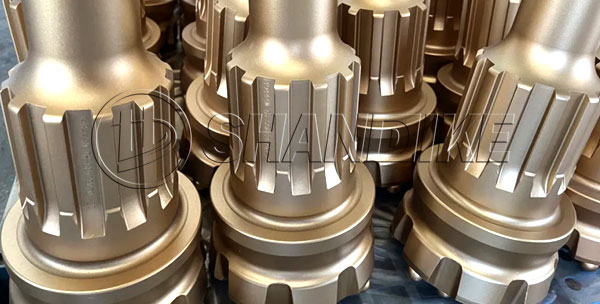
Maintenance and Management:
Regular Inspections: Conduct thorough inspections of the drill bit for signs of wear, cracks, or damage. Promptly replace worn-out bits to forestall further degradation and ensure efficient drilling.
Storage Conditions: Store drill bits in a dry, rust-free environment to prevent corrosion and deterioration.
Professional Training: Provide operators with training on the proper use and maintenance of drill bits. Proper handling and operation can drastically reduce abnormal wear and extend the bit’s life.
Specific Considerations for Diamond Bits:
For diamond bits, additional factors to consider include:
Diamond Quality: The grade, size, and concentration of diamonds in the bit impact its lifespan. Choose bits with diamonds that are well-suited for the intended drilling application.
Matrix Composition: The matrix material and its properties are crucial in supporting the diamonds and ensuring they are effectively exposed for cutting. Optimize the matrix composition to match the drilling conditions and material being drilled.
Manufacturing Process: The manufacturing process, including sintering and brazing techniques, can affect the bit’s durability. Ensure high-quality manufacturing to minimize defects and enhance performance.
Pre-Shipping Checklist:
Ensure the drill bit does not come into contact with the metal surface, especially avoiding the bottom of the alloy buttons touching each other.
Carefully inspect the drill bit before shipping and jot down the drill bit number and serial number for future reference.
Foot Valve Maintenance:
Verify the correct installation of the foot valve and its proper exposed height. Ensure the foot valve is intact.
Inspect for damaged and corroded impact ends, typically due to inadequate lubrication. A cracked impact tip often stems from severe wear of the piston, circlip, or bottom bushing.
DTH Button Bit Maintenance:
Drill Bit Head Maintenance:
In highly abrasive formations, the drill body wears down faster than the alloy buttons, a phenomenon known as “drill erosion.” To minimize alloy button breakage, grind them so they are no higher than 9 mm from the drill bit surface.
Control the depth of the chip removal groove due to abrasiveness and wear on the body caused by high drilling speeds. Frequently regrind the flutes to ensure effective debris removal.
Severe erosion and the force of the piston hitting the drill bit can cause alloy buttons to fall off, known as “button loss.” This can occur even with minor erosion. When drilling into soft formations, frequently remove the drill bit for cleaning to maintain constant contact between the drill bit surface and the bottom rock.
Increasing the rotation speed does not necessarily boost the penetration rate but rather increases the wear frequency, particularly in abrasive layers. Under abrasive conditions, control the wear frequency based on the required drilling depth.
A flattened surface button typically indicates a lack of flow energy from the hammer or insufficient torque. Inspect the drill bit for minute cracks at the bottom. Failure to address this condition can lead to surface chipping and ultimately complete failure of the bottom.
1、 Product Overview and Applications
The 6 “QL60 DTH (Down The Hole) Hammer is a downhole impact hammer designed specifically for mining and water well drilling in South Africa and other regions. With its advanced technology and high-quality materials, the hammer exhibits excellent durability and performance, suitable for rock formations of various hardness, and can efficiently break rocks, significantly improving drilling efficiency.
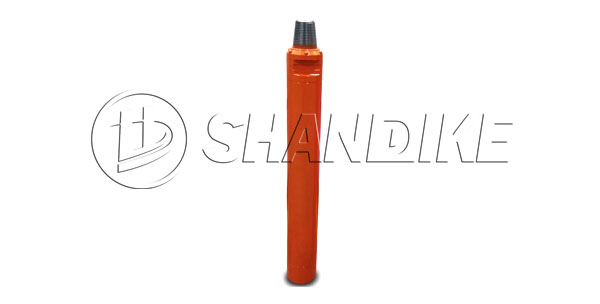
The 6.5” HP QL60 Hammer is a Rock Hog Drilling Products Brand 6” Class QL60 Shank Hammer. The 6.5” HP QL60 Hammer is a Model-65 Hi-Performance, Heavy duty model for QL6 shank bit. The drill pipe connection-3-1/2 REG API pin up type configuration.
This hammer has an OD of 5.90” (150mm) and discard OD size is 5.43”(135.6mm). This hammer has slightly larger internals than the RH61QHD1HP. This allows for faster penetration rates.
In South Africa, this DTH Hammer is widely used in the following scenarios:
Mining: As a globally renowned mineral rich country, QL60 DTH Hammer plays a crucial role in the mining process in South Africa, used to break rocks and improve the overall efficiency of mining operations.
Water well drilling: In some areas of South Africa where water resources are scarce, water well drilling has become an important means of obtaining groundwater resources. QL60 DTH Hammer can quickly penetrate rock layers and achieve ideal drilling depths, providing stable water resources for local residents.
Geological exploration: QL60 DTH Hammer also plays an indispensable role in geological exploration work in South Africa, used to obtain underground rock samples and provide valuable data support for geological research.
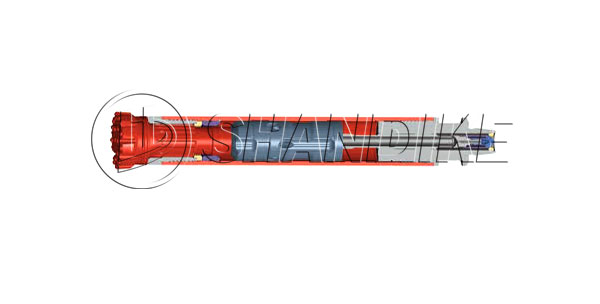
2、 Product Features
Efficient drilling: QL60 DTH Hammer has won wide acclaim in drilling operations in South Africa for its powerful impact and efficient drilling speed.
Strong durability: Made of high-quality stainless steel and other high-strength materials, QL60 DTH Hammer still performs well in the harsh drilling environment of South Africa, extending the product’s service life.
Wide applicability: QL60 DTH Hammer is not only suitable for mining and water well drilling, but also widely used in various fields such as geological exploration, meeting the drilling needs of different customers in South Africa.
Easy to maintain: The reasonable design makes the QL60 DTH Hammer easy to disassemble and assemble, making it convenient for South African users to carry out daily maintenance and upkeep work.
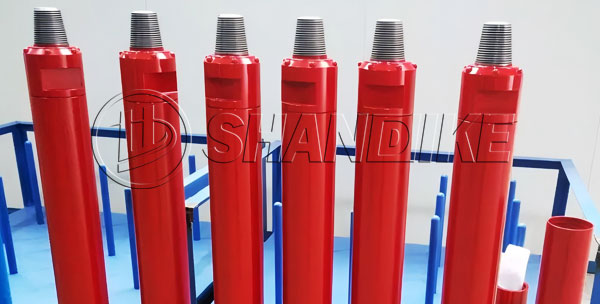
3、 Price and purchasing advice
In South Africa, the price of QL60 DTH Hammer varies depending on factors such as supplier, order quantity, and delivery conditions. Generally speaking, the price range of these products is between hundreds and thousands of dollars. In order to obtain more favorable prices and reliable delivery guarantees, it is recommended that South African users follow the following advice when purchasing:
Choose a well-known supplier: When purchasing, choose a supplier with good reputation and strong technical strength to ensure product quality and after-sales service. In South Africa, some well-known drilling equipment suppliers may offer sales and services for QL60 DTH Hammer.
Understanding product specifications: Before purchasing, it is important to have a detailed understanding of the product’s specifications, performance, and usage conditions to ensure that the selected product meets actual needs. Especially pay attention to key parameters such as the outer diameter, discarded outer diameter, and internal components of the product.
Negotiating prices and delivery terms: When negotiating prices with suppliers, factors such as order quantity and delivery time should be fully considered to obtain more favorable prices and more reliable delivery guarantees. At the same time, it is also necessary to understand the supplier’s after-sales service policy to ensure timely technical support and maintenance services during use.
In summary, the 6 “QL60 DTH Hammer has broad application prospects in the fields of mining, water well drilling, and geological exploration in South Africa. South African users should choose well-known suppliers when purchasing, understand product specifications, and negotiate prices and delivery terms with suppliers to ensure the purchase of cost-effective products.
QL60 High Air Pressure DTH Hammer With Foot Valve Specification:
| Items | Replacement Parts |
| 1 | Top sub |
| 2 | O-ring of top sub |
| 3 | Breakout Ring |
| 4 | Check Valve |
| 5 | Spring |
| 6 | Compression Buffer |
| 7 | Air Distributor |
| 8 | Internal cylinder |
| 9 | Piston |
| 10 | External cylinder |
| 11 | Guide sleeve |
| 12 | O-ring of stop ring |
| 13 | Stop ring |
| 14 | Breakout ring |
| 15 | Drive chunk |
| 16 | Drill bit |
| Drilling Diameter(mm) | Hammer Length Without Bit(mm) | External Diameter(mm) | Weight Without Bit(kg) | ||||
| φ155-φ190 | 1212 | 142mm, 144mm,146mm, 148mm | 95 | ||||
| Working Pressure(Mpa) | Air Consumption(m³/min) | ||||||
| 1.5-2.5 Mpa | 1.0Mpa: 10 m³/min | 1.8Mpa: 20 m³/min | 2.4Mpa: 28.5 m³/min | ||||
| Impact rate at 17 bar | Recommended Rotation Speed | Connection Rod Thread | Bit Shank | ||||
| 23HZ | 20-30 r/min. | API 3 1/2” Reg | QL60 | ||||
T45 89mm button bits, also known as T45 specification button bits with a diameter of 89mm, are a drilling tool designed specifically for high efficiency and wear resistance.
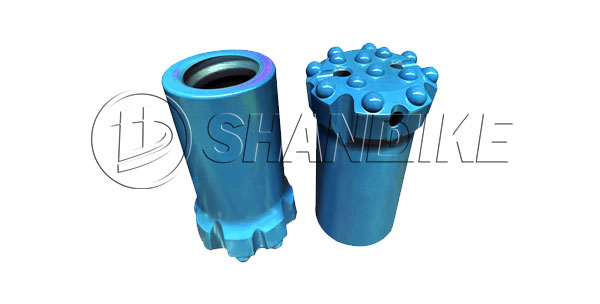
1、 Main features
Efficient and wear-resistant: This drill bit is made of durable hard alloy material, ensuring a long service life and reliable operational performance, especially suitable for demanding construction and mining applications.
Wide applicability: This drill bit is not only suitable for construction projects, but also widely used in the energy and mining industries, meeting the diverse needs of different users.
Multiple shapes and designs: T45 89mm button bits are typically equipped with different types of buttons such as spherical, ballistic, and flat or descending center designs to accommodate different drilling conditions and rock types.
2、 Product specifications
Diameter: 89 millimeters (approximately 3.5 inches)
Type: Button Bit
Specification and model: T45
Button specifications: may include buttons of different sizes, such as 8 × 13mm, 4 × 12mm, etc., depending on product design and manufacturer.
Number of flushing holes: Depending on product design and application requirements, different numbers of flushing holes may be equipped.
3、 Application scenarios
T45 89mm button bits are mainly used for hard rock drilling operations, including but not limited to the following scenarios:
Mining operation: Used for drilling ore and rock samples during the mining process, or conducting drilling operations before blasting.
Construction engineering: In foundation engineering, tunnel engineering, and underground engineering, it is used to drill holes for underground passages, basements, and subway tunnels.
Energy industry: used for drilling boreholes and conducting geological exploration in the exploration and development of oil, natural gas, and geothermal energy.
4、 Product advantages
Improving drilling efficiency: Due to the use of wear-resistant materials and optimized design, T45 89mm button bits can significantly improve drilling efficiency and reduce drilling costs.
Extended service life: The use of hard alloy materials gives the drill bit a longer service life, reducing the frequency of drill bit replacement and downtime.
Enhancing safety: Optimized drill bits and stable drilling performance can help reduce safety risks during the drilling process.
5、 Manufacturers and suppliers
T45 89mm button bits are produced by professional manufacturers such as SHANDIKE. These manufacturers usually have rich production experience and advanced technological strength, and can provide high-quality products and excellent after-sales service.
In summary, T45 89mm button bits are an efficient, wear-resistant, and widely applicable drilling tool for the construction and mining industries. Its superior performance and diverse design enable it to meet the diverse needs of different users, and play an important role in improving drilling efficiency and reducing costs.

Specification Confirmation:
Firstly, ascertain the taper. The taper plays a crucial role in ensuring the stability of the connection and the efficiency of torque transmission between the drill rod and the drill bit. Common tapers utilized are 7 degrees, 11 degrees, and 12 degrees. Secondly, determine the appropriate diameter. For softer rocks, diameters ranging from Φ19 to Φ22 mm are suitable. Medium-hard rocks require diameters between Φ25 and Φ28 mm, while hard rocks necessitate diameters of Φ32 mm or larger. Lastly, establish the necessary length of the drill rod, which should align with the drilling depth and construction specifications. Our offerings include short drill rods (400-800 mm), medium-long drill rods (1000-1600 mm), and long drill rods (2000 mm and above).
Matching Rock Drill Specifications:
Ensure that the connection end specifications of the drill rod are compatible with the interface of the rock drill machine. Common connection end specifications include 22 x 108 mm and 25 x 108 mm.
Importance of Tapered Rock Drill Rods:
Tapered rock drill rods are indispensable tools in rock drilling operations. They boast high strength, wear resistance, reliable connections, and efficient operation. These rods are extensively utilized in a variety of drilling and rock crushing applications.

Hexagonal Hollow Steel H22/H25 Tapered Drill Rods are precision tools meticulously crafted for rock drilling applications.
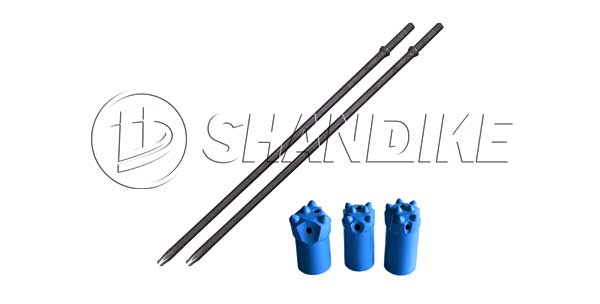
1. Product Highlights
Material Composition & Design:
Crafted primarily from premium steel grades like 55SiMnMo, these rods guarantee robust strength and exceptional wear resistance. Their innovative hexagonal hollow design not only reduces overall weight but also bolsters torsional rigidity and operational stability.
Specifications & Dimensions:
Available in two primary specifications, H22 and H25, these rods cater to a wide array of drilling requirements, accommodating various aperture sizes and drilling depths. Lengths can be tailored to customer specifications, typically ranging from 1m to 5m. Taper angles, such as 7° and 11°, are tailored to suit diverse drilling methodologies.
Versatile Applications:
These rods excel in mining, tunnel excavation, geological exploration, and more. They are particularly adept at shallow hole drilling operations with pneumatic or hydraulic drilling machines.

2. Outstanding Performance Benefits
Strength & Durability:
Through rigorous heat treatment and advanced manufacturing processes, the hardness and wear resistance of these drill rods are significantly enhanced, prolonging their lifespan. They maintain consistent performance even in the most arduous drilling conditions.
Robust Connectivity:
Equipped with threading or other advanced connection methods, these rods ensure seamless integration during drilling, fostering stability and operational continuity. Their compatibility with a range of drilling rigs and bits elevates drilling efficiency.
User-Friendly Design:
The ergonomic design of these rods ensures they are lightweight, portable, and straightforward to install. Operators can effortlessly manage the rod’s direction and penetration depth during drilling operations.
3. Market Demand & Future Prospects
Rising Demand:
The burgeoning mining and tunnel excavation industries are driving up the demand for high-quality drill rods. In particular, complex geological formations necessitate robust, wear-resistant, and highly connectable rods.
Progressive Enhancements:
As technology advances and manufacturing processes refine, the performance of hexagonal hollow steel H22/H25 conical drill rods will continue to improve. They are poised to become even more ubiquitous in diverse drilling applications, propelling industry growth.
4. Purchase Considerations
Trusted Manufacturers:
When acquiring these rods, prioritize manufacturers with proven credentials and a solid reputation. This ensures you receive superior product quality and dependable after-sales support.
Informed Decisions:
Before making a purchase, thoroughly familiarize yourself with the rod’s specifications, dimensions, performance characteristics, and other pertinent details. This will empower you to select the ideal rod for your needs.
Price & Value:
While price is a crucial consideration, it should not be the sole determinant. Evaluate the rod’s cost-effectiveness, balancing quality, performance, and price to make an informed decision.
In conclusion, the hexagonal hollow steel H22/H25 conical drill rod is a formidable drilling tool, characterized by its superior performance, ease of use, and versatility across mining, tunnel excavation, and other industries. When acquiring these rods, choose a reputable manufacturer, understand their capabilities, and strike the right balance between price and value.
Specification
| Shank size | Length in mm | Length in feet |
| 22×108 | 610 | 2 |
| 22×108 | 1220 | 4 |
| 22×108 | 1830 | 6 |
| 22×108 | 1980 | 6-1/2 |
| 22×108 | 2440 | 8 |
| 22×108 | 3050 | 10 |
| 22×108 | 3660 | 12 |
| 22×108 | 5485 | 18 |
| 22×108 | 6400 | 21 |
| 22×108 | 7315 | 24 |
| 25×108 | 1500 | 4,9 |
| 25×108 | 1830 | 6 |
| 25×108 | 2000 | 6-1/2 |
| 25×108 | 2200 | 7,2 |
| 25×108 | 3050 | 10 |
QL80 DTH Spherical (Ballistic) Button Bits
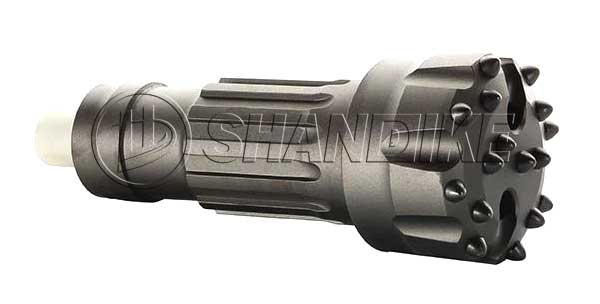
1. Overview
QL80 DTH Spherical (Ballistic) Button Bits are specifically designed for pneumatic impact drilling (DTH) rigs. They are suitable for drilling operations in various hard rock and abrasive formations. The unique spherical (or ballistic, depending on the model) tooth setting design enhances the wear resistance and drilling efficiency of the drill bit.
2. Main Features
Strong Wear Resistance: Made of high-quality alloy steel material and subjected to special heat treatment, these bits offer improved wear resistance and service life.
High Drilling Efficiency: The spherical or ballistic toothed design effectively crushes rocks and increases drilling speed.
Strong Adaptability: Suitable for drilling into various hard rocks and abrasive formations, such as granite, marble, and basalt.
Easy to Replace: Designed with standard specifications, these bits are compatible with various DTH drilling machines, making them easy to replace and maintain.
3. Technical Parameters
Model: QL80
Diameter: Typically 203mm (8 inches), but specific dimensions may vary based on the manufacturer and application.
Gear Shape: Spherical or ballistic (tapered shape similar to a bullet or missile tip).
Drill Face Shape: Flat, concave, or convex, selected according to specific needs.
Work Pressure: Usually within the range of 8-30 bar, depending on the drilling rig and formation conditions.
Packaging: Wooden crates are used for packaging to ensure safe transportation.
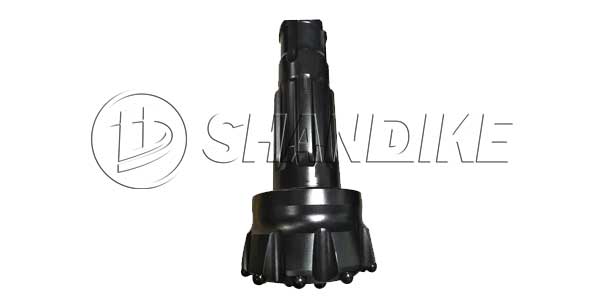
4. Application Fields
QL80 DTH Spherical (Ballistic) Button Bits are widely used in mining, water well drilling, geological exploration, building foundation construction, and other fields. Their superior performance and wear resistance are particularly recognized in projects requiring drilling into hard rock and abrasive formations.
5. Supplier and Purchasing Suggestions
Multiple professional manufacturers, both domestically and internationally, produce QL80 DTH Spherical (Ballistic) Button Bits, such as Luoyang Shandike Mechanical Equipment Co., Ltd. in China. When purchasing, it is recommended to choose the appropriate model and specifications based on specific needs and budget. Additionally, select suppliers with a good reputation and after-sales service to ensure product quality and support.
6. Working Principle
During operation, the pressure regulating mechanism pushes the drill tool forward, keeping the drill bit in contact with the rock at the bottom of the hole. The DTH hammer at the front end of the drill rod, under the action of air pressure, continuously impacts the drill bit. The bit obtains impact energy and sinks into the bottom of the hole, generating an impact force that crushes the rock.
7. Popular Models
The most popular specifications include:
QL80-203mm/8’’, 819+1219
QL80-216mm/8 1/2’’, 1019+619+8*19
QL80-222mm/8 3/4’’, 1219+619+8*19
QL80-254mm/10’’, 1019+619+8*19
The exact bit size can vary depending on specific drilling requirements. The buttons can be spherical or ballistic, chosen based on the rock formation.
8. Function of Splines Designs
Processing strictly in accordance with design requirements to ensure proper clearance and uniformity of splines.
Carburizing and quenching of the surface to increase surface hardness and resistance to plastic deformation and impact fatigue.
Reducing surface roughness and improving contact accuracy.
Increasing the cross-sectional area of the splines to enhance the strength of the drill bit.
Summary
QL80 DTH Spherical (Ballistic) Button Bits are a high-performance and wear-resistant pneumatic impact drill bit suitable for various hard rock and abrasive formations. When selecting and using these bits, reasonable choices should be made based on specific needs and conditions. For faster penetration in softer rock formations, ballistic button bits may be preferred, while spherical button bits may be more suitable for harder rock or longer durability requirements.
Drifting and tunneling R25 drill rods are used in underground mining and construction projects. They are made of high-strength steel and have a hollow core and a threaded connection system on both ends.

Drilling Technique:
R25 drill rods are used with a variety of drilling techniques, including hand-held rock drills, pneumatic rock drills, and electric rock drills. They are suitable for use in drilling both soft and hard rock formations.
Size and Length:
The standard diameter of an R25 drill rod is 25mm (about 1 inch). The length of the rods can vary depending on the specific drilling application, but they are typically available in lengths ranging from 1 to 6 meters (3 to 20 feet). Extension rods can also be used to extend the reach of the drill bit and can be threaded together with other R25 drill rods to create a longer drill string.

Thread Type and Coupling:
R25 drill rods have a specific thread type and coupling system that is used in conjunction with other components of the drilling system. They are threaded on both ends and use an R25 thread connection. The coupling is designed to provide a secure and tight fit to prevent leakage and ensure efficient drilling.
Applications:
R25 drill rods are commonly used in vertical and inclined boreholes in underground mining and tunneling applications. They are often used in narrow tunnels for drilling blast holes and in wells for geotechnical investigations. R25 drill rods are also frequently used in infrastructure projects such as highway construction, tunneling, and dam construction.
Advantages:
R25 drill rods are highly durable and wear-resistant, making them ideal for use in challenging underground conditions. They have high tensile strength, which means they can withstand significant pressure from the drill rig. The threaded connection system allows for easy assembly and disassembly of the drill string, which saves time and increases efficiency on the job site. Additionally, R25 drill rods have a longer lifespan compared to other types of drill rods, which can help reduce costs over time.
R25 Drifting & Tunneling Tools
R25 (1″) bit thread, Button bit diameter: 33mm, 35mm, 37mm, 38mm, 41mm, 43mm
Cross bit diameter: 33mm, 35mm, 38mm
Reaming bit, 6° taper, bit diameter: 64mm, 76mm, 89mm
Pilot adapter, 6° taper, R25 thread, diameter: 26mm
Drifter rod, R32-Hex25-R25, length: 2200mm, 2400mm, 2600mm, 2800mm, 3090mm, 3700mm
Coupling sleeve, R25, 150mm length
An R32 extension drill rod is a type of drilling tool used in underground mining and construction projects. It is a thin-walled, hollow steel rod with a diameter of 32mm and a length that can vary depending on the requirements of the project. The R32 extension drill rod is designed to be attached to a drilling rig and lowered into a borehole to reach deeper levels of the earth. It is typically used to extend the reach of the drill bit and can be threaded together with other R32 drill rods to create a longer drill string. The durability and strength of the R32 extension drill rod make it ideal for use in challenging underground conditions where the drill string may need to be rotated under high torque and pressure.
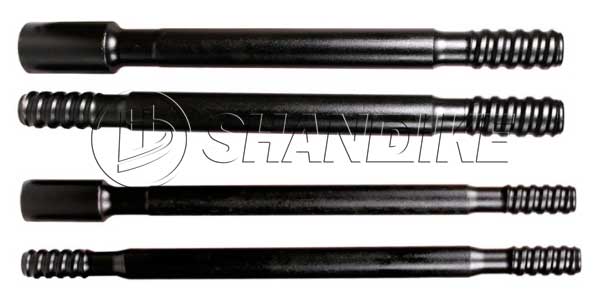
Construction:
R32 extension drill rods are usually constructed using high-grade alloy steel with a hollow core, which makes them lightweight but still strong enough to withstand the stresses of drilling. The rods are threaded on both ends to allow for easy connection to other rods, as well as to the drill bit and the drilling rig.
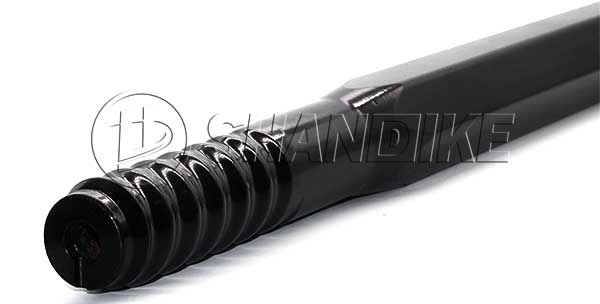
Size and Length:
The standard diameter of an R32 extension drill rod is 32mm (about 1.26 inches), but they can also be manufactured in larger diameters if needed. The length of the rods can vary depending on the specific drilling application, but they are typically available in lengths ranging from 1 to 6 meters (3 to 20 feet).
Thread Type:
R32 extension drill rods have a specific thread type that is used in conjunction with other components of the drilling system. The thread design is usually chosen based on the requirements of the project, and can be standard or customized if necessary.
Applications:
R32 extension drill rods are commonly used for underground drilling in mining and construction applications where a long reach is required. They can be used for a range of drilling techniques including rotary drilling, percussive drilling, and diamond drilling. These drill rods are ideal for use in directional drilling, as they are able to maintain a straight line while drilling at angles, even in very hard rock conditions.
Advantages:
R32 extension drill rods are known for their strength, durability, and wear resistance, making them a popular choice for many drilling applications. They are also relatively lightweight, which makes them easier to handle and transport. Additionally, the hollow core of the rods allows for high-pressure air or water to be pumped through them, which can be useful for clearing debris from the borehole during drilling operations.
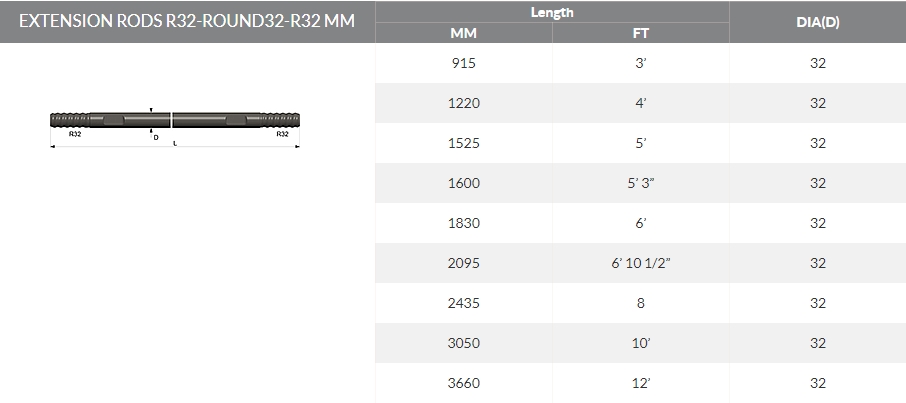
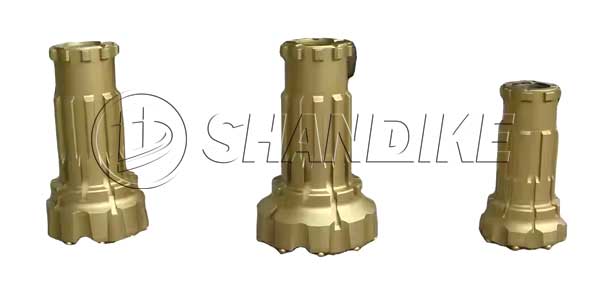
Precision-hardened keys are lighter in weight and enable shorter shank lengths.
The shank design offers the highest piston-to-bit weight ratio, maximizing energy at the button face.
An airflow channel design and control minimize bit face plugging and eliminate unwanted pressurization of surrounding formations.
Custom and standard sizes are available up to 43 inches in diameter.
Full-gauge underreamers are designed for overburden conditions.
Thanks to SHANDIKE’s long history in drilling, we understand bits. First and foremost, we recognize the significance of a durable, effective design leading your tooling down the hole. Art Holte invented the key drive system. Consequently, our complete line of reverse circulation bits can be quickly changed with hand tools.
Precision-hardened keys are the cornerstone of our key drive system, replacing traditional splines. This allows for shorter shank lengths and lighter weight bits with very high piston-to-bit weight ratios. Delivering maximum energy to the button face means the drill is efficiently bringing rock chips to the surface, rather than wasting time creating dust.
Tapered airflow channels reduce the likelihood of bit face plugging to ensure the hammer continues to operate in all types of conditions. Careful control of airflow better directs air to the center of the bit face, helping to eliminate the unwanted pressurization of surrounding formations—making drilling in sensitive sites less risky.
SHANDIKE RC bits are available in a variety of shank styles. An innovative two-piece design utilizes tungsten carbide or optional diamond buttons for the utmost in durability. Sizes range up to 43 inches (1092mm). Our flexible design, manufacturing, and heat treatment processes are capable of adapting to meet your needs. RC underreamer bits are also available.
The drill bit violently and low impact breaks the rock during rock drilling, thereby achieving the purpose of drilling boreholes in the rock. During use, alloy teeth inevitably collide and rub against rocks, resulting in wear. Wear is a normal failure mode of alloy teeth without fracture. The ultimate failure mode of the drill bit is also due to the wear of the alloy teeth, which makes it impossible to continue drilling rocks and ends. Wear is usually caused by collisions and friction between alloy teeth and rocks during the drilling process. Hard particles in the rock first plow into the softer bonding parts of the alloy teeth, causing them to be worn away first. In the subsequent cutting motion, WC grains that lose their bonding phase protection peel off, thereby grinding off a small part of the alloy teeth. Under the loading of rock drilling machinery, the alloy teeth continuously wear out, and the relative motion and contact area between the alloy and the rock also increase, further accelerating the wear of the alloy teeth.
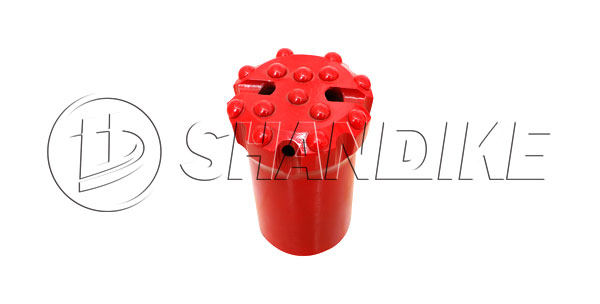
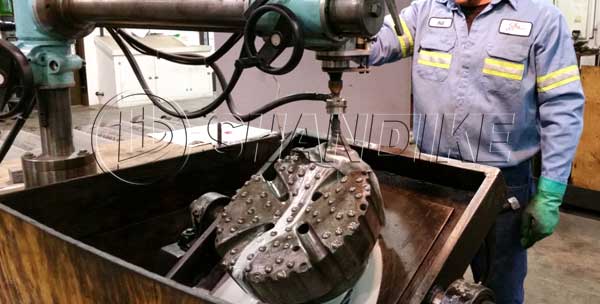
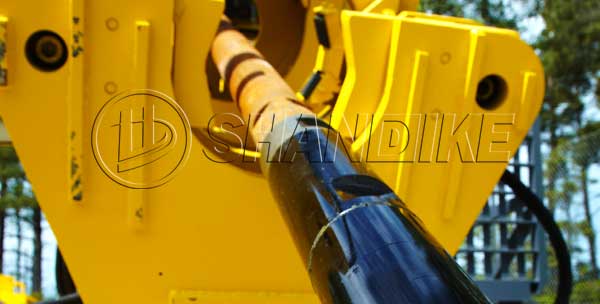
High wind pressure impactor is a type of rock drilling tool, but unlike other rock drilling tools, it always stays at the bottom of the hole during the drilling process, and the piston directly impacts the drill bit. Compressed gas enters the impactor through the drill rod and is then discharged from the drill bit, and the exhaust gas is used to discharge slag. The rotary motion of the impactor is provided by the rotary head of the drilling rig, and the axial thrust is provided by the propulsion mechanism of the drilling rig, which is transmitted to the impactor through the drill rod.
2、 Structural principle
The down the hole impactor is composed of a piston, an inner cylinder, a valve seat, a check valve, and drill bit accessories installed in a slender outer cylinder. The upper end of the outer cylinder is equipped with an upper joint with a plate handle and a connecting thread, and the lower end is equipped with a threaded clamping sleeve. The clamping sleeve is mainly used to transmit thrust and rotary motion to the drill bit, and the clamping ring controls the axial movement of the drill bit. The check valve is used to prevent debris such as rock slag from entering the impactor when the supply of compressed air is stopped. During the drilling process, the drill bit is pushed into the impactor and pressed against the clamping sleeve. At this time, the piston directly impacts the drill bit into rock drilling. When the drill bit is lifted off the bottom of the hole, it begins to forcefully blow and discharge slag.
3、 Precautions for use and operation
January 11, 2024
January 11, 2024